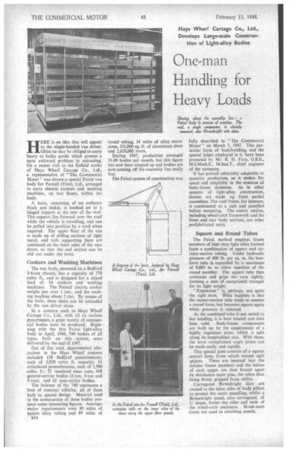One-man Handling for Heavy Loads
Page 48

If you've noticed an error in this article please click here to report it so we can fix it.
HERE is an idea that will appeal to the single-handed van driver. Often he may be obliged to carry heavy or bulky goods which present a most awkward problem in unloading. On a recent visit to the Enfield works of Hays • Wharf Cartage Co., Ltd., a representative of "The Commercial Motor" was shown a special Fairal van body for Parnall (Yate), Ltd., arranged to carry electric cookers and washing machines, on two floors, within the body.
A hoist, consisting of an ordinary block and tackle, is hooked on to a hinged iopport at the rear of the roof. This support lies forward over the roof while the vehicle is travelling, and can be pulled into position by a cord when required. The upper floor of the van is made up of sliding sections of light metal, and rails supporting them are continued on the inner sides of the rear doors, so that the end section can be slid out under the hoist.
Cookers and Washing Machines The van body, mounted on a Bedford 3-4-ton chassis, has a capacity of 770 cubic ft., and is designed for a mixed load of 34 cookers and washing machines. The Parnall electric cooker weighs just over 1 cwt., and the washing machine about 2 cwt. By means of the hoist, these items can be unloaded by the van driver alone.
In a concern such as Hays Wharf Cartage Co., Ltd., with all its various departments, a great variety of commercial bodies must be produced. Beginning with the first Fairal light-alloy body in April, 1946, 740 bodies of all types, built OD this system, were delivered by the end of 1947.
Out of this total, departmental allocations in the Hays Wharf concern included 138 Bedford pantechnicons, each of 1,020 cubic ft. capacity; 33 articulated pantechnicons, each of 1,500 cubic, ft.; 25 insulated meat vans; 418 general-service bodies (2-ton, 3-ton and 5-ton); and 62 semi-trailer bodies.
The balance of the 740 represents a host of contract vehicles, all of them built to special design. Material used in the construction of these bodies presents some interesting figures. Amongst 'Major. requirements were 89 miles of square alloy tubing and 89 miles of .• U14
round tubing, 14 miles of alloy extrusions, 331,000 sq. ft. of aluminium sheet and 2.620,600 rivets.
During 1947, production averaged 51.09 bodies per month, but this figure has now been stepped up and bodies are now coming off the assembly line really fast_ The Fairal system of construction was fully described in "The Commercial Motor" on March 7, 1947. This particular form of bodybuilding, and the special joints employed in it, have been protected by Mr. R. H. Faro, 0.B.E., M.I.TVFech.E., M.Inst.T., chief engineer of the company.
It has proved admirably adaptable to quantity production, as it makes for speed and simplicity in the erection of body-frame skeletons. As in other systems of light-alloy construction, frames are made up from partial assemblies. The roof frame, for instance, is constructed as a unit and panelled before mounting. The centre section, including wheel-arch framework and the front and rear body sections, are other prefabricated units.
Square and Round Tubes The Fairal method employs frame members of high-duty light alloy formed from a combination of square and circular-section tubing. Under hydraulic pressure of 400 lb. per sq. in. the boxform tube is expanded by a maximum of 0.005 in. to allow insertion of the round member. The square tube then contracts and grips the core tightly, forming a unit of exceptional strength for its light weight.
"Expansion" is, perhaps, not quite the right term. What happens is that the square-section tube tends to assume a round form, but becomes square again when pressure is released.
As the combined tube is not suited to hot bending, it is heat treated and then bent cold. Body-frame components are built up by the employment of a highly ingenious piece, which is split along its. longitudinal axis. With these, the most complicated angle joints can be made easily and rapidly.
This special joint consists of a square central boss, from which extend split spigots. These are inserted into the tubular frame members and the halves of each spigot are then forced apart' by duralumin taper pins, the tubes thus being firmly gripped from within. Corrugated Birmabright slats are riveted to the inner sides of body pillars to protect the outer panelling, whilst a Birmabright panel, also corrugated, of U shape, forms the sides and ends of the wheel-arch enclosure. Break-stem rivets are used in attaching panels.




















































































